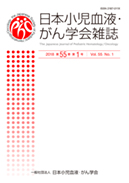Volume 59, Issue 1
Displaying 1-14 of 14 articles from this issue
- |<
- <
- 1
- >
- >|
The 62nd Annual Meeting of the Japanese Society of Pediatric Hematology / Oncology
-
2022 Volume 59 Issue 1 Pages 1-6
Published: 2022
Released on J-STAGE: May 12, 2022
Download PDF (7389K)
-
2022 Volume 59 Issue 1 Pages 7-11
Published: 2022
Released on J-STAGE: May 12, 2022
Download PDF (902K)
-
2022 Volume 59 Issue 1 Pages 12-18
Published: 2022
Released on J-STAGE: May 12, 2022
Download PDF (780K)
Original Article
-
2022 Volume 59 Issue 1 Pages 19-23
Published: 2022
Released on J-STAGE: May 12, 2022
Download PDF (843K) -
2022 Volume 59 Issue 1 Pages 24-29
Published: 2022
Released on J-STAGE: May 12, 2022
Download PDF (1448K)
Case Report
-
2022 Volume 59 Issue 1 Pages 30-34
Published: 2022
Released on J-STAGE: May 12, 2022
Download PDF (3805K) -
2022 Volume 59 Issue 1 Pages 35-38
Published: 2022
Released on J-STAGE: May 12, 2022
Download PDF (2766K) -
2022 Volume 59 Issue 1 Pages 39-43
Published: 2022
Released on J-STAGE: May 12, 2022
Download PDF (2418K) -
2022 Volume 59 Issue 1 Pages 44-49
Published: 2022
Released on J-STAGE: May 12, 2022
Download PDF (4159K)
Report of Committee
-
2022 Volume 59 Issue 1 Pages 50-57
Published: 2022
Released on J-STAGE: May 12, 2022
Download PDF (882K) -
2022 Volume 59 Issue 1 Pages 58-65
Published: 2022
Released on J-STAGE: May 12, 2022
Download PDF (2456K)
Report
-
2022 Volume 59 Issue 1 Pages 66-69
Published: 2022
Released on J-STAGE: May 12, 2022
Download PDF (817K) -
2022 Volume 59 Issue 1 Pages 70-75
Published: 2022
Released on J-STAGE: May 12, 2022
Download PDF (5900K) -
2022 Volume 59 Issue 1 Pages 77-99
Published: 2022
Released on J-STAGE: May 12, 2022
Download PDF (55870K)
- |<
- <
- 1
- >
- >|
